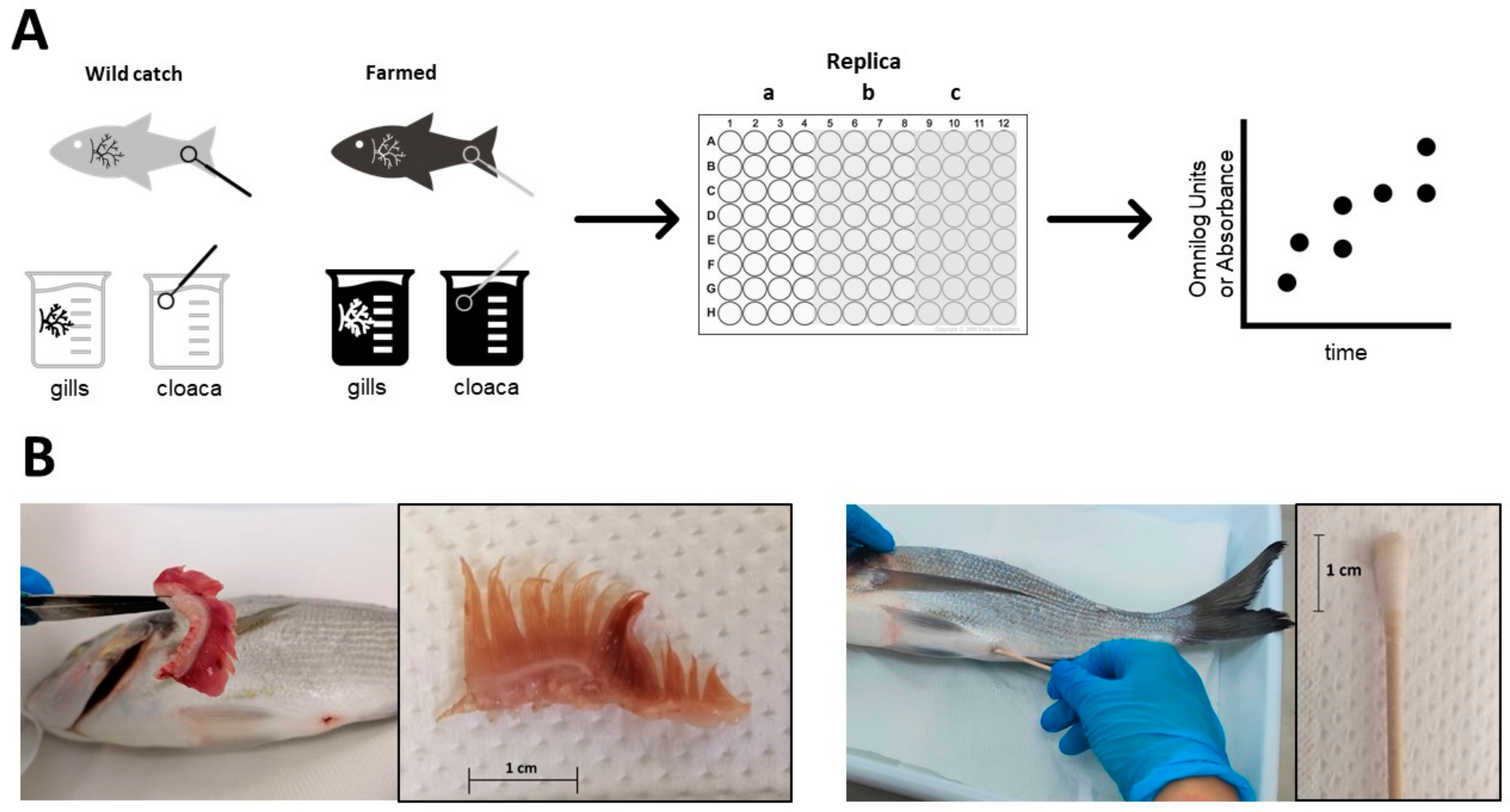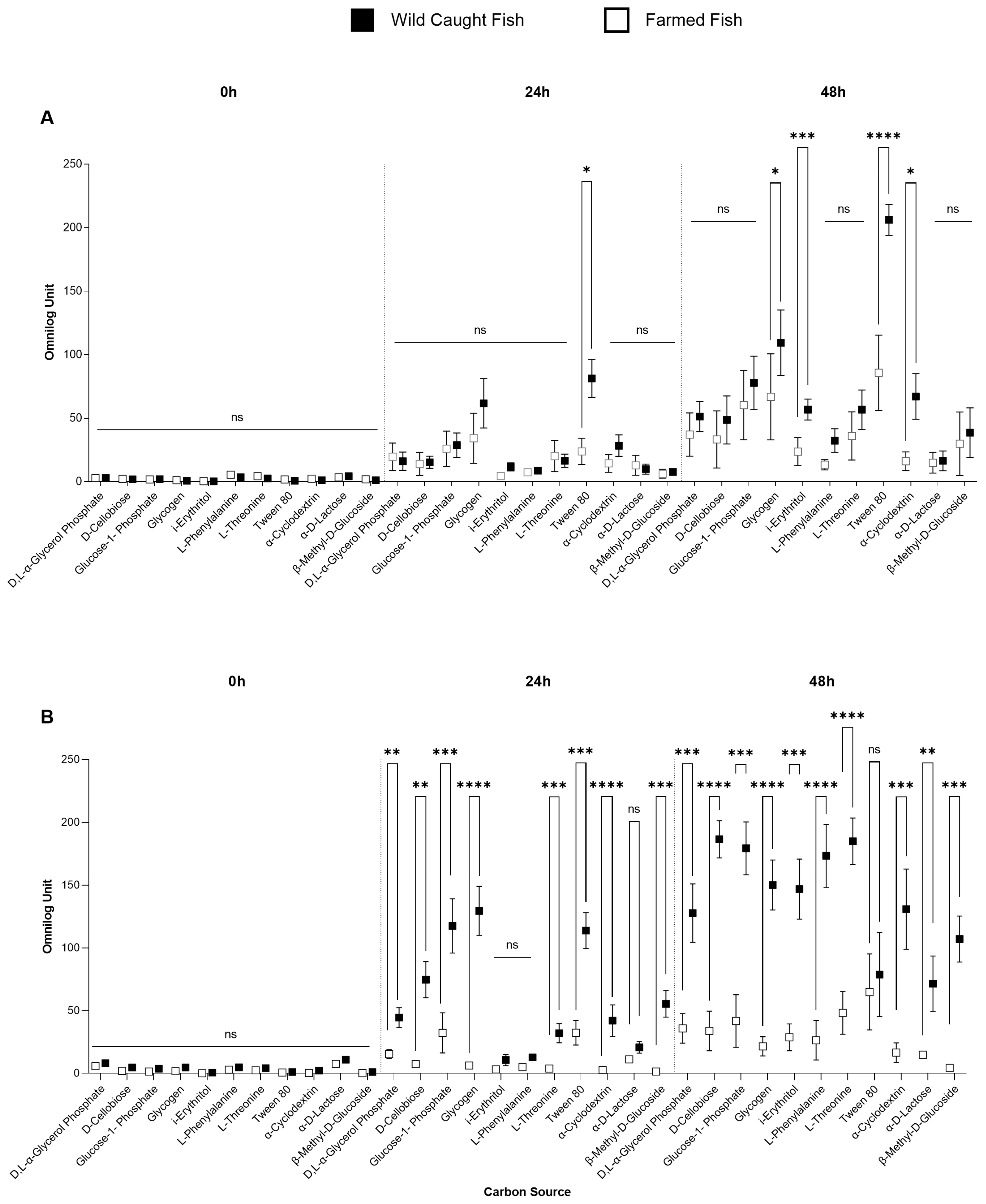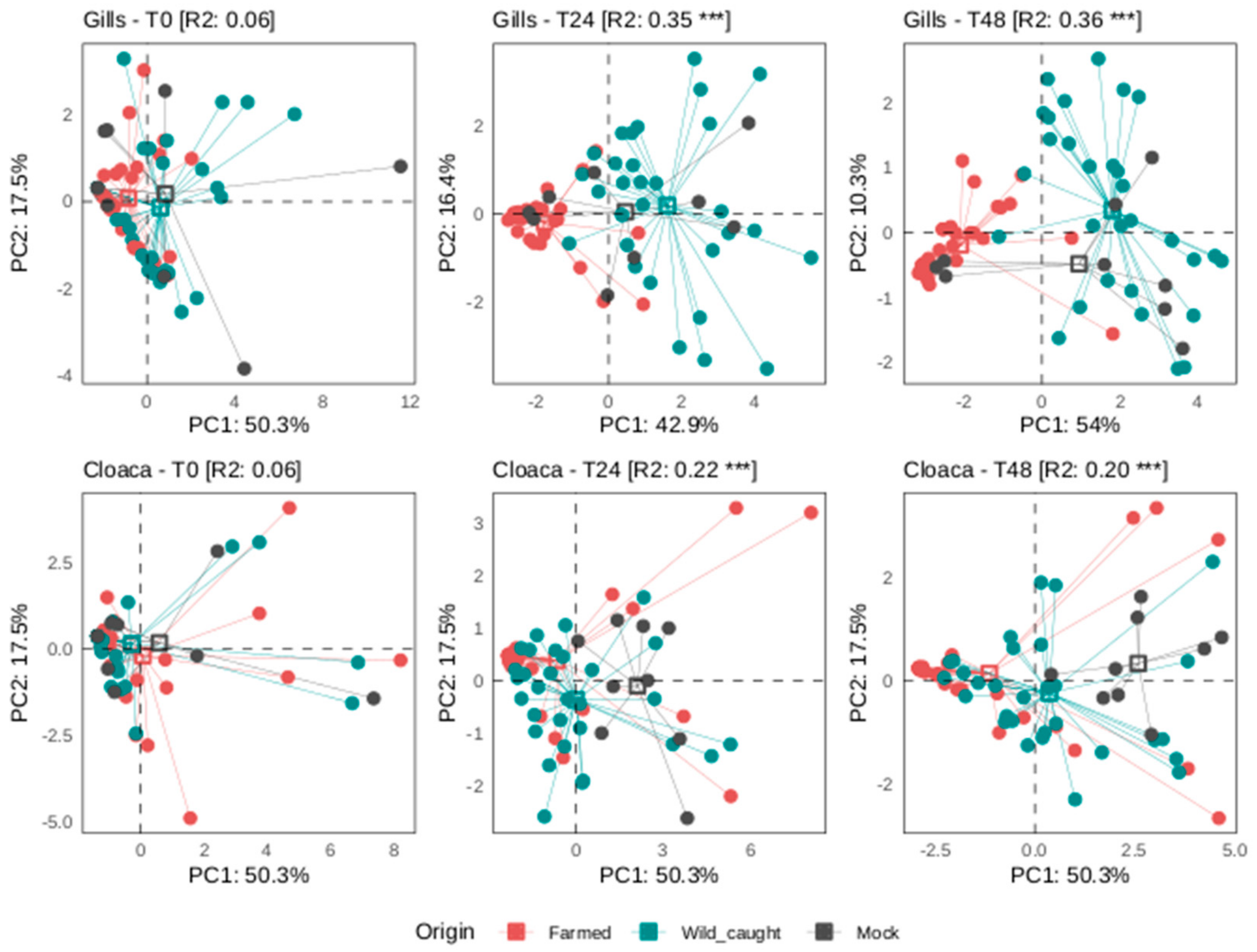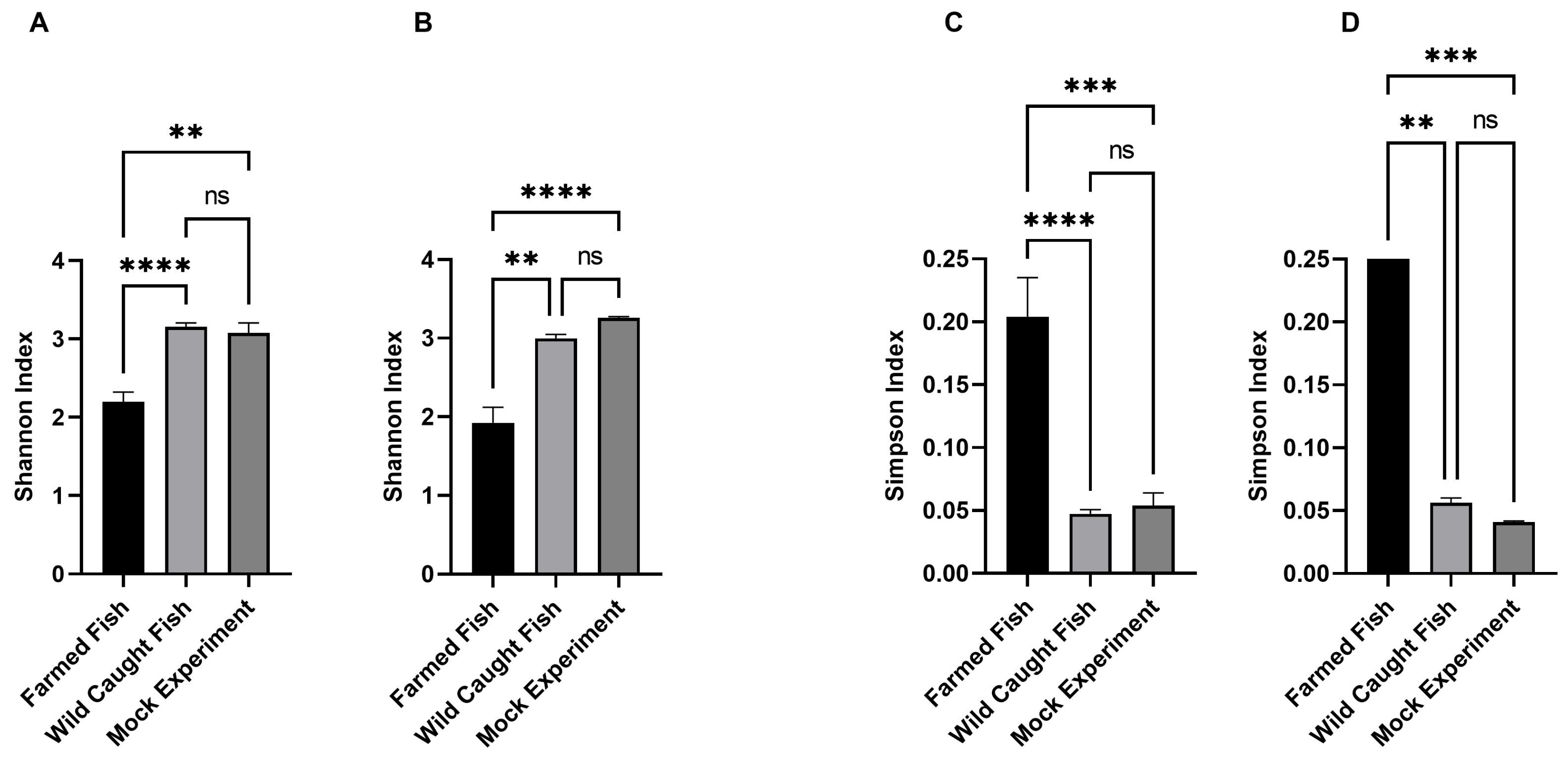A Microbial Phenomics Approach to Determine Metabolic Signatures to Enhance Seabream Sparus aurata Traceability, Differentiating between Wild-Caught and Farmed
Abstract
:1. Introduction
2. Materials and Methods
2.1. Fish Material and Dissections
2.2. Sample Preparation for EcoPlate Assay
2.3. Statistical Analysis
3. Results
3.1. Selected Carbon Sources by Microbial Communities from Both Wild-Caught and Farmed Specimens
3.2. Comparison of the Gills and the Cloaca
3.3. Mock Experiment
4. Discussion
5. Conclusions
Supplementary Materials
Author Contributions
Funding
Institutional Review Board Statement
Informed Consent Statement
Data Availability Statement
Conflicts of Interest
References
- Islam, S.; Cullen, J.M. Food Traceability: A Generic Theoretical Framework. Food Control 2021, 123, 107848. [Google Scholar] [CrossRef]
- EU Eurobarometer. Available online: https://europa.eu/eurobarometer (accessed on 24 May 2024).
- The EU Agri-Food Fraud Network and the Administrative Assistance and Cooperation System, Annual Report. 2020. Available online: https://food.ec.europa.eu/safety/acn/reports-and-publications_en (accessed on 24 May 2024).
- Donnelly, K.A.M.; Olsen, P. Catch to Landing Traceability and the Effects of Implementation—A Case Study from the Norwegian White Fish Sector. Food Control 2012, 27, 228–233. [Google Scholar] [CrossRef]
- Pereira, L.A.; Santos, R.V.; Hauser, M.; Duponchelle, F.; Carvajal, F.; Pecheyran, C.; Bérail, S.; Pouilly, M. Commercial Traceability of Arapaima Spp. Fisheries in the Amazon Basin: Can Biogeochemical Tags Be Useful? Biogeosciences 2019, 16, 1781–1797. [Google Scholar] [CrossRef]
- Tulli, F.; Moreno-Rojas, J.M.; Messina, C.M.; Trocino, A.; Xiccato, G.; Muñoz-Redondo, J.M.; Santulli, A.; Tibaldi, E. The Use of Stable Isotope Ratio Analysis to Trace European Sea Bass (D. labrax) Originating from Different Farming Systems. Animals 2020, 10, 2042. [Google Scholar] [CrossRef] [PubMed]
- Pascual-García, A.; Bell, T. Community-Level Signatures of Ecological Succession in Natural Bacterial Communities. Nat. Commun. 2020, 11, 2386. [Google Scholar] [CrossRef]
- Faust, K.; Bauchinger, F.; Laroche, B.; de Buyl, S.; Lahti, L.; Washburne, A.D.; Gonze, D.; Widder, S. Signatures of Ecological Processes in Microbial Community Time Series. Microbiome 2018, 6, 120. [Google Scholar] [CrossRef]
- Callao, M.P.; Ruisánchez, I. An Overview of Multivariate Qualitative Methods for Food Fraud Detection. Food Control 2018, 86, 283–293. [Google Scholar] [CrossRef]
- Cristina Dos Santos, R.; Fokar, M.; Romagnoli, E.M.; Aziz, M.; Bento, J.M.S.; Paré, P.W. Monitoring a Beneficial Bacterium (Bacillus Amyloliquefaciens) in the Rhizosphere with Arugula Herbivory. Rhizosphere 2021, 18, 100347. [Google Scholar] [CrossRef]
- González, M.-L.; Fuentes, M.E.; Molina, V.; Quiñones, R.A. Effects of Ethoxyquin on Metabolism and Composition of Active Marine Microbial Communities. Aquaculture 2023, 569, 739345. [Google Scholar] [CrossRef]
- Niu, S.; Zhang, K.; Li, Z.; Xie, J.; Wang, G.; Li, H.; Yu, E.; Xia, Y.; Tian, J.; Gong, W. Analysis of the Structure and Function of Microbial Community in Late-Stage of Grass Carp (Ctenopharyngodon idella) Farming Ponds. Aquac. Rep. 2023, 30, 101556. [Google Scholar] [CrossRef]
- Sas-Paszt, L.; Trzciński, P.; Lisek, A.; Gluszek, S.; Matysiak, B.; Kaniszewski, S. The Influence of Consortia of Beneficial Microorganisms on the Growth and Yield of Aquaponically Grown Romaine Lettuce. Agronomy 2023, 13, 546. [Google Scholar] [CrossRef]
- Griffiths, B.S.; Ritz, K.; Wheatley, R.E. Relationship between Functional Diversity and Genetic Diversity in Complex Microbial Communities. In Microbial Communities; Springer: Berlin/Heidelberg, Germany, 1997; pp. 1–9. [Google Scholar]
- Regione Toscana, L.R. N. 66/2005 Programma Annuale Pesca Professionale e Acquacoltura 2006. Available online: https://www.regione.toscana.it/documents/10180/70946/programma_pesca_2006/21d1061a-8360-416e-b0f7-b668532e8891 (accessed on 24 May 2024).
- Council Regulation (EC). No. 2597/95 of 23 October 1995 on the Submission of Nominal Catch Statistics by Member States Fishing in Certain Areas Other than Those of the North Atlantic. Official J. 1995, L 270, 1–33. [Google Scholar]
- Community Ecology Package [R Package Vegan Version 2.6-6.1]. 2024. Available online: https://doi.org/10.32614/CRAN.PACKAGE.VEGAN (accessed on 24 May 2024).
- R Core Team, R. A Language and Environment for Statistical Computing; R Foundation for Statistical Computing: Vienna, Austria, 2024; Available online: https://www.r-project.org/ (accessed on 24 May 2024).
- Galieva, G.S.; Gilmutdinova, I.M.; Fomin, V.P.; Selivanovskaya, S.Y.; Galitskaya, P.Y. Monitoring Soil Bacteria with Community-Level Physiological Profiles Using BiologTM ECO-Plates in the Republic of Tatarstan (Russia). IOP Conf. Ser. Earth Environ. Sci. 2018, 107, 012057. [Google Scholar] [CrossRef]
- Bonizzi, I.; Feligini, M.; Aleandri, R.; Enne, G. Genetic Traceability of the Geographical Origin of Typical Italian Water Buffalo Mozzarella Cheese: A Preliminary Approach. J. Appl. Microbiol. 2007, 102, 667–673. [Google Scholar] [CrossRef] [PubMed]
- Feligini, M.; Panelli, S.; Sacchi, R.; Ghitti, M.; Capelli, E. Tracing the Origin of Raw Milk from Farm by Using Automated Ribosomal Intergenic Spacer Analysis (ARISA) Fingerprinting of Microbiota. Food Control 2015, 50, 51–56. [Google Scholar] [CrossRef]
- El Shobaky, A.; Meile, J.-C.; Montet, D. New Traceability Strategies Based on a Biological Bar Code by PCR-DGGE Using Bacterial and Yeast Communities for Determining Farming Type of Peach. Egypt. J. Basic Appl. Sci. 2015, 2, 327–333. [Google Scholar] [CrossRef]
- Kafantaris, I.; Amoutzias, G.D.; Mossialos, D. Foodomics in Bee Product Research: A Systematic Literature Review. Eur. Food Res. Technol. 2021, 247, 309–331. [Google Scholar] [CrossRef]
- da Silva Costa, R.; Sainara Maia Fernandes, T.; de Sousa Almeida, E.; Tomé Oliveira, J.; Carvalho Guedes, J.A.; Julião Zocolo, G.; Wagner de Sousa, F.; do Nascimento, R.F. Potential Risk of BPA and Phthalates in Commercial Water Bottles: A Minireview. J. Water Health 2021, 19, 411–435. [Google Scholar] [CrossRef]
- Sala-Comorera, L.; Blanch, A.R.; Casanovas-Massana, A.; Monleón-Getino, A.; García-Aljaro, C. Traceability of Different Brands of Bottled Mineral Water during Shelf Life, Using PCR-DGGE and next Generation Sequencing Techniques. Food Microbiol. 2019, 82, 1–10. [Google Scholar] [CrossRef]
- Cauchie, E.; Delhalle, L.; Taminiau, B.; Tahiri, A.; Korsak, N.; Burteau, S.; Fall, P.A.; Farnir, F.; Baré, G.; Daube, G. Assessment of Spoilage Bacterial Communities in Food Wrap and Modified Atmospheres-Packed Minced Pork Meat Samples by 16S RDNA Metagenetic Analysis. Front. Microbiol. 2020, 10, 3074. [Google Scholar] [CrossRef]
- Koo, O.-K.; Baker, C.A.; Kim, H.-J.; Park, S.H.; Ricke, S.C. Metagenomic Assessment of the Microbial Diversity in Ground Pork Products from Markets in the North Central Region of South Korea. J. Environ. Sci. Health Part B 2016, 51, 622–627. [Google Scholar] [CrossRef] [PubMed]
- Shehata, H.R.; Mitterboeck, T.F.; Hanner, R. Characterization of the Microbiota of Commercially Traded Finfish Fillets. Food Res. Int. 2020, 137, 109373. [Google Scholar] [CrossRef] [PubMed]
- Meriggi, N.; Russo, A.; Renzi, S.; Cerasuolo, B.; Nerini, M.; Ugolini, A.; Marvasi, M.; Cavalieri, D. Enhancing Seafood Traceability: Tracking the Origin of Seabass and Seabream from the Tuscan Coast Area by the Analysis of the Gill Bacterial Communities. Anim. Microbiome 2024, 6, 13. [Google Scholar] [CrossRef]
- Sofo, A.; Ricciuti, P. A Standardized Method for Estimating the Functional Diversity of Soil Bacterial Community by Biolog® EcoPlates Assay—The Case Study of a Sustainable Olive Orchard. Appl. Sci. 2019, 9, 4035. [Google Scholar] [CrossRef]
- Insam, H. A New Set of Substrates Proposed for Community Characterization in Environmental Samples. In Microbial Communities; Springer: Berlin/Heidelberg, Germany, 1997; pp. 259–260. [Google Scholar]
- Flynn, T.M.; Koval, J.C.; Greenwald, S.M.; Owens, S.M.; Kemner, K.M.; Antonopoulos, D.A. Parallelized, Aerobic, Single Carbon-Source Enrichments from Different Natural Environments Contain Divergent Microbial Communities. Front. Microbiol. 2017, 8, 2321. [Google Scholar] [CrossRef] [PubMed]
- Haack, S.K.; Garchow, H.; Klug, M.J.; Forney, L.J. Analysis of Factors Affecting the Accuracy, Reproducibility, and Interpretation of Microbial Community Carbon Source Utilization Patterns. Appl. Environ. Microbiol. 1995, 61, 1458–1468. [Google Scholar] [CrossRef]
- Rutgers, M.; Wouterse, M.; Drost, S.M.; Breure, A.M.; Mulder, C.; Stone, D.; Creamer, R.E.; Winding, A.; Bloem, J. Monitoring Soil Bacteria with Community-Level Physiological Profiles Using BiologTM ECO-Plates in the Netherlands and Europe. Appl. Soil Ecol. 2016, 97, 23–35. [Google Scholar] [CrossRef]
- Hackett, C.A.; Griffiths, B.S. Statistical Analysis of the Time-Course of Biolog Substrate Utilization. J. Microbiol. Methods 1997, 30, 63–69. [Google Scholar] [CrossRef]
- Pratte, Z.A.; Besson, M.; Hollman, R.D.; Stewart, F.J. The Gills of Reef Fish Support a Distinct Microbiome Influenced by Host-Specific Factors. Appl. Environ. Microbiol. 2018, 84, e0063-18. [Google Scholar] [CrossRef]
- Gajardo, K.; Rodiles, A.; Kortner, T.M.; Krogdahl, Å.; Bakke, A.M.; Merrifield, D.L.; Sørum, H. A High-Resolution Map of the Gut Microbiota in Atlantic Salmon (Salmo salar): A Basis for Comparative Gut Microbial Research. Sci. Rep. 2016, 6, 30893. [Google Scholar] [CrossRef]
- Evariste, L.; Barret, M.; Mottier, A.; Mouchet, F.; Gauthier, L.; Pinelli, E. Gut Microbiota of Aquatic Organisms: A Key Endpoint for Ecotoxicological Studies. Environ. Pollut. 2019, 248, 989–999. [Google Scholar] [CrossRef] [PubMed]





Disclaimer/Publisher’s Note: The statements, opinions and data contained in all publications are solely those of the individual author(s) and contributor(s) and not of MDPI and/or the editor(s). MDPI and/or the editor(s) disclaim responsibility for any injury to people or property resulting from any ideas, methods, instructions or products referred to in the content. |
© 2024 by the authors. Licensee MDPI, Basel, Switzerland. This article is an open access article distributed under the terms and conditions of the Creative Commons Attribution (CC BY) license (https://creativecommons.org/licenses/by/4.0/).
Share and Cite
Nerini, M.; Russo, A.; Decorosi, F.; Meriggi, N.; Viti, C.; Cavalieri, D.; Marvasi, M. A Microbial Phenomics Approach to Determine Metabolic Signatures to Enhance Seabream Sparus aurata Traceability, Differentiating between Wild-Caught and Farmed. Foods 2024, 13, 2726. https://doi.org/10.3390/foods13172726
Nerini M, Russo A, Decorosi F, Meriggi N, Viti C, Cavalieri D, Marvasi M. A Microbial Phenomics Approach to Determine Metabolic Signatures to Enhance Seabream Sparus aurata Traceability, Differentiating between Wild-Caught and Farmed. Foods. 2024; 13(17):2726. https://doi.org/10.3390/foods13172726
Chicago/Turabian StyleNerini, Marta, Alessandro Russo, Francesca Decorosi, Niccolò Meriggi, Carlo Viti, Duccio Cavalieri, and Massimiliano Marvasi. 2024. "A Microbial Phenomics Approach to Determine Metabolic Signatures to Enhance Seabream Sparus aurata Traceability, Differentiating between Wild-Caught and Farmed" Foods 13, no. 17: 2726. https://doi.org/10.3390/foods13172726





